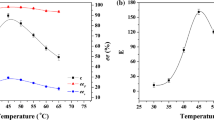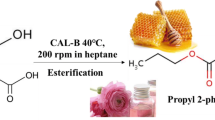Abstract
Kinetic resolution of 1-(4-(trifluoromethyl)phenyl)ethanol (TFMP) enantiomers was achieved through lipase-catalyzed transesterification in organic solvents. Lipase PS from Pseudomonas cepacia was selected as the best biological catalyst, and vinyl acetate was used as the acyl donor for the transesterification in isooctane. The effects of temperature, enzyme dosage, substrate ratio and time on the reaction were investigated. Response surface methodology was introduced as the tool for process optimization and the optimized conditions were obtained. The experimental results under the optimized conditions involving the temperature of 46 °C, substrate ratio of 1:12, enzyme dosage of 15 mg and time of 104 min, show that TFMP enantiomers were resolved with the enantiomeric excess of the remaining substrate (ees) higher than 99.0% and the conversion (c) of 50.3%, which indicates an efficient kinetic resolution process.











Similar content being viewed by others
References
Liu H, Duan WD, De Souza FZR, Liu L, Chen BS (2018) Asymmetric ketone reduction by immobilized Rhodotorula mucilaginosa. Catalysts 8:165. https://doi.org/10.3390/catal8040165
Harwood LA, Wong LL, Robertson J (2020) Enzymatic kinetic resolution by addition of oxygen. Angew Chem Int Ed 60:4434–4447. https://doi.org/10.1002/anie.202011468
Lorenz H, Seidel-Morgenstern A (2014) Processes to separate enantiomers. Angew Chem Int Ed 53:1218–1250. https://doi.org/10.1002/anie.201302823
Berkessel A, Sebastian-Ibarz M, Müller T (2006) Lipase/aluminum-catalyzed dynamic kinetic resolution of secondary alcohols. Angew Chem Int Ed 45:6567–6570. https://doi.org/10.1002/anie.200600379
Jiang W, Fang BS (2020) Synthesizing chiral drug intermediates by biocatalysis. Appl Biochem Biotechnol 192:146–179. https://doi.org/10.1007/s12010-020-03272-3
Hönig M, Sondermann P, Turner NJ, Carreira EM (2017) Enantioselective chemo- and biocatalysis: partners in retrosynthesis. Angew Chem Int Ed 56:8942–8973. https://doi.org/10.1002/anie.201612462
Lian XZ, Fang Y, Joseph E, Wang Q, Li JL, Banerjee S, Lollar C, Wang X, Zhou HC (2017) Enzyme-MOF (metal-organic framework) composites. Chem Soc Rev 46:3386–3401. https://doi.org/10.1039/c7cs00058h
Green AP, Turner NJ (2016) Biocatalytic retrosynthesis: redesigning synthetic routes to high-value chemicals. Perspect Sci 9:42–48. https://doi.org/10.1016/j.pisc.2016.04.106
Turner NJ, O’Reilly E (2013) Biocatalytic retrosynthesis. Nat Chem Biol 9:285–288. https://doi.org/10.1038/nchembio.1235
Karadeniz F, Bayraktar E, Mehmetoglu U (2010) Kinetic resolution of racemic 1-phenyl-1-propanol by lipase catalyzed enantioselective esterification reaction. Artif Cells Blood Substit Immobil Biotechnol 38:288–293. https://doi.org/10.3109/10731199.2010.494579
Chandrasekaran SM, Bhartiya S, Wangikar PP (2006) Substrate specificity of lipases in alkoxycarbonylation reaction: QSAR model development and experimental validation. Biotechnol Bioeng 94:554–564. https://doi.org/10.1002/bit.20879
Kim H, Choi YK, Lee J, Lee EY, Park J, Kim MJ (2011) Ionic-surfactant-coated burkholderia cepacia lipase as a highly active and enantioselective catalyst for the dynamic kinetic resolution of secondary alcohols. Angew Chem 123:11136–11140. https://doi.org/10.1002/ange.201104141
Klibanov AM (2001) Improving enzymes by using them in organic solvents. Nature 409:241–246. https://doi.org/10.1002/chin.200114287
de Miranda AS, Miranda LSM, de Souza ROMA (2015) Lipases: valuable catalysts for dynamic kinetic resolutions. Biotechnol Adv 33(5):372–393. https://doi.org/10.1016/j.biotechadv.2015.02.015
Moreira K, de Oliveira ALB, de Moura Júnior LS et al (2022) Taguchi design-assisted co-immobilization of lipase A and B from Candida antarctica onto chitosan: characterization, kinetic resolution application, and docking studies. Chem Eng Res Des 177:223–244. https://doi.org/10.1016/j.cherd.2021.10.033
Garcia-Galan C, Barbosa O, Hernandez K, Santos J, Rodrigues R, Fernandez-Lafuente R (2014) Evaluation of styrene-divinylbenzene beads as a support to immobilize lipases. Molecules 19(6):7629–7645. https://doi.org/10.3390/molecules19067629
Fernandez-Lopez L, Bartolome-Cabrero R, Rodriguez MD, Dos Santos CS, Rueda N, Fernandez-Lafuente R (2015) Stabilizing effects of cations on lipases depend on the immobilization protocol. RSC Adv 5(102):83868–83875. https://doi.org/10.1039/C5RA18344H
Valério RBR, Cavalcante ALG, Mota GF (2022) Understanding the biocatalytic potential of lipase from rhizopus chinensis. Biointerface Res Appl Chem 12(3):4230–4260. https://doi.org/10.33263/BRIAC123.42304260
da Fonseca AM, de Freitas ÍB, Soares NB et al (2022) Synthesis, biological activity, and in silico study of bioesters derived from bixin by the CALB enzyme. Biointerface Res Appl Chem 12(5):5901–5917. https://doi.org/10.3263/BRIAC125.59015917
Lima GV, da Silva MR, de Sousa FT et al (2017) Chemoenzymatic synthesis of (S)-Pindolol using lipases. Appl Catal A Gen 546:7–14. https://doi.org/10.1016/j.apcata.2017.08.003
Monteiro RRC, de Oliveira ALB, de Menezes FL et al (2022) Improvement of enzymatic activity and stability of lipase A from Candida antartica onto halloysite nanotubes with Taguchi method for optimized immobilization. Appl Clay Sci 228:106634. https://doi.org/10.1016/j.clay.2022.106634
Pinheiro MP, Rios NS, Fonseca TDS et al (2018) Kinetic resolution of drug intermediates catalyzed by lipase B from Candida antarctica immobilized on immobead-350. Biotechnol Progr 34(4):878–889. https://doi.org/10.1002/btpr.2630
Bezerra RM, Monteiro RRC, Neto DMA et al (2020) A new heterofunctional support for enzyme immobilization: PEI functionalized Fe3O4 MNPs activated with divinyl sulfone application in the immobilization of lipase from Thermomyces lanuginosus. Enzyme Microb Technol 138:109560. https://doi.org/10.1016/j.enzmictec.2020.109560
Galvão WS, Pinheiro BB, Golçalves LRB et al (2018) Novel nanohybrid biocatalyst: application in the kinetic resolution of secondary alcohols. J Mater Science 53(20):14121–14137. https://doi.org/10.1007/s10853-018-2641-5
Verdasco-Martín CM, Villalba M, dos Santos JCS et al (2016) Effect of chemical modification of Novozym 435 on its performance in the alcoholysis of camelina oil. Bioch Eng 111:75–86. https://doi.org/10.1016/j.bej.2016.03.004
Moreira KDS, de Oliveira ALB, Júnior LSDM et al (2020) Lipase from Rhizomucor miehei immobilized on magnetic nanoparticles: performance in fatty acid ethyl ester (FAEE) optimized production by the taguchi method. Front Bioeng Biotech 8:693. https://doi.org/10.3389/fbioe.2020.00693
Liu DM, Dong C (2020) Recent advances in nano-carrier immobilized enzymes and their applications. Process Biochem 92:464–475. https://doi.org/10.1016/j.procbio.2020.02.005
Zahirinejad S, Hemmati R, Homaei A, Dinari A, Hosseinkhani S, Mohammadi S, Vianello F (2021) Nano-organic supports for enzyme immobilization: scopes and perspectives. Colloid Surface B 204:111774. https://doi.org/10.1016/j.colsurfb.202
Silva ARM, Alexandre JYNH, Souza JES (2022) The Chemistry and applications of metal-organic frameworks (MOFs) as industrial enzyme immobilization systems. Molecules 27:4529. https://doi.org/10.3390/molecules27144529
Lima PJM, da Silva RM, Neto CACG et al (2021) An overview on the conversion of glycerol to value-added industrial products via chemical and biochemical routes. Biotechnol Appl Bioc 68:2098. https://doi.org/10.1002/bab.2098
Mota GF, de Sousa IG, de Oliveira ALB et al (2022) Biodiesel production from microalgae using lipase-based catalysts: current challenges and prospects. Algal Res 62:102616. https://doi.org/10.1016/j.algal.2021.102616
Cavalcante FTT, Neto FS, de Aguiar Falcão IR et al (2020) Opportunities for improving biodiesel production via lipase catalysis. Fuel 288:119577. https://doi.org/10.1016/j.fuel.2020.119577
Cavalcante FTT, da Fonseca AM, Alexandre JYNH, dos Santos JCS (2022) A stepwise docking and molecular dynamics approach for enzymatic biolubricant production using Lipase Eversa® transform as a biocatalyst. Ind Crop Prod 187:115450. https://doi.org/10.1016/j.indcrop.2022.115450
Dheeman DS, Frias JM, Henehan GTM (2010) Influence of cultivation conditions on the production of a thermostable extracellular lipase from Amycolatopsis mediterranei DSM 43304. J Ind Microbiol Biotechnol 37:1–17. https://doi.org/10.1007/s10295-009-0643-7
Tokunaga M, Larrow JF, Kakiuchi F (1997) Asymmetric catalysis with water: efficient kinetic resolution of terminal epoxides by means of catalytic hydrolysis. Science 277:936–938. https://doi.org/10.2307/2892907
Jaeger KE, Eggert T (2002) Lipases for biotechnology. Curr Opin Biotech 13:390–397. https://doi.org/10.4028/www.scientific.net/MSF.636-637.1194
Singh AK, Mukhopadhyay M (2016) Lipase-catalyzed glycerolysis of olive oil in organic solvent medium: optimization using response surface methodology. Korean J Chem Eng 33:1247–1254. https://doi.org/10.1007/s11814-015-0272-y
Cai ZQ, Cai JY, Li SS, Zhang WJ, Shi S, Zhu XL (2014) Biosynthesis of myristyl serinate by immobilized Candida antarctica lipase in two-phase system. J Mol Catal B: Enzym 108:118–122. https://doi.org/10.1016/j.molcatb.2014.07.008
Ghanem A, Aboul-Enein HY (2004) Lipase-mediated chiral resolution of racemates in organic solvents. Tetrahedron Asymmetry 15(21):3331–3351. https://doi.org/10.1002/chin.200508294
Palmeira DJ, Abreu JC, Andrade LH (2011) Lipase-catalyzed kinetic resolution of aryltrimethylsilyl chiral alcohols. Molecules 16:9697–9713. https://doi.org/10.3390/molecules16119697
Yuan X, Liu GY, Zhang PL, Xu WF, Tang KW (2019) Lipase-catalyzed production of (S)-carprofen enhanced by hydroxyethyl-β-cyclodextrins: experiment and optimization. Org Process Res Dev 23:891–899. https://doi.org/10.1021/acs.oprd.9b00009
Nishihara T, Shiomi A, Kadotani S, Nokami T, Iton T (2017) Remarkable improved stability and enhanced activity of a burkholderia cepacia lipase by coating with a triazolium alkyl-PEG sulfate ionic liquid. Green Chem 19:5250–5256. https://doi.org/10.1039/C7GC02319G
Shahedi M, Yousefi M, Habibi Z, Mohammadi M (2019) Co-immobilization of rhizomucor miehei lipase and candida antarctica lipase b and optimization of biocatalytic biodiesel production from palm oil using response surface methodology. Renewable Energy 141:847–857. https://doi.org/10.1016/j.renene.2019.04.042
Chen Y, Xia NN, Liu YW, Wang P (2019) Efficient biocatalytic preparation of optically pure (R)-1-[4-(trifluoromethyl)phenyl]ethanol by recombinant whole-cell-mediated reduction. Catalysts 9:391. https://doi.org/10.3390/catal9040391
Tsamis F, Gavrilov S, Kajumo F, Seibert C, Kuhmann S, Ketas T, Trkola A, Palani A, Clader JW, Tagat JR, McCombie S, Baroudy B, Moore JP, Sakmar TP, Dragic T (2003) Analysis of the mechanism by which the small-molecule CCR5 antagonists SCH-351125 and SCH-350581 Inhibit human immunodeficiency virus type 1 entry. Virol J 77:5201–5208. https://doi.org/10.1128/JVI.77.9.5201-5208.2003
Tagat JR, Steensma RW, McCombie SW, Nazareno DV, Lin SI, Neustadt BR, Cox K, Xu S, Wojcik L, Murray MG, Vantuno N, Baroudy BM, Strizki JM (2001) Piperazine-based CCR5 antagonists as HIV-1 inhibitors. II. discovery of 1-[(2,4-dimethyl-3-pyridinyl)carbonyl]-4-methyl-4-[3(S)-methyl-4-[1(S)-[4-(trifluoromethyl)phenyl]ethyl]-1-piperazinyl]-piperidine N1-oxide (Sch-350634), an orally bioavailable, potent CCR5 antagonist. J Med Chem 44:3343–3346. https://doi.org/10.1021/jm0155401
Kumar A, Dhar K, Singh S, Arora PK (2016) Lipase catalysis in organic solvents: advantages and applications. Biol Proced Online 18:2. https://doi.org/10.1186/s12575-016-0033-2
Laane C, Boeren S, Vos K, Veeger C (2009) Rules for optimization of biocatalysis in organic solvents. Biotechnol Bioeng 102:1–8. https://doi.org/10.1002/bit.22209
Kharrat N, Ali YB, Marzouk S, Gargouri YT, Karra-Châabouni M (2011) Immobilization of rhizopus oryzae lipase on silica aerogels by adsorption: comparison with the free enzyme. Process Biochem 46:1083–1089. https://doi.org/10.1016/j.procbio.2011.01.029
Kaewthong W, Kittikun AH (2004) Glycerolysis of palm olein by immobilized lipase PS in organic solvents. Enzyme Microb Technol 35:218–222. https://doi.org/10.1016/j.enzmictec.2004.04.011
Li X, Xu L, Wang G, Zhang H, Yan Y (2013) Conformation studies on Burkholderia cenocepacia lipase via resolution of racemic 1-phenylethanol in non-aqueous medium and its process optimization. Process Biochem 48:1905–1913. https://doi.org/10.1016/j.procbio.2013.09.001
Hazarika S, Goswami P, Dutta NN (2002) Ethyl oleate synthesis by Porcine pancreatic lipase in organic solvents. Chem Eng J 85:61–68. https://doi.org/10.1016/s1385-8947(01)00144-9
Kovalenko G, Perminova L, Beklemishev A (2020) Heterogeneous biocatalytical esterification by recombinant Thermomyces lanuginosus lipase immobilized on macroporous carbon aerogel. Catal Today 379:36–41. https://doi.org/10.1016/j.cattod.2020.11.018
Stepankova V, Bidmanova S, Koudelakova T, Prokop Z, Chaloupkova R, Damborsky J (2013) Strategies for stabilization of enzymes in organic solvents. Acs Catal 3:2823–2836. https://doi.org/10.1021/cs400684x
Phillips RS (1996) Temperature modulation of the stereochemistry of enzymatic catalysis: prospects for exploitation. Trends Biotechnol 14:13–16. https://doi.org/10.1016/0167-7799(96)80908-5
Gupta SM, Kamble MP, Yadav GD (2017) Insight into microwave assisted enzyme catalysis in process intensification of reaction and selectivity: kinetic resolution of (R, S)-flurbiprofen with alcohols. Mol Catal 440:50–53. https://doi.org/10.1016/j.mcat.2017.06.020
Sanchez A, Cruz J, Rueda N, dos Santos JCS et al (2016) Inactivation of immobilized trypsin under dissimilar conditions produces trypsin molecules with different structures. RSC Adv 6(33):27329–27334. https://doi.org/10.1039/c6ra03627a
Yuan X, Ou J, Zhang PL, Xu WF, Jiang BH, Tang KW (2020) PEG-modified lipase immobilized onto NH2-MIL-53 MOF for efficient resolution of 4-fluoromandelic acid enantiomers. Int J Biol Macromol 165:1793–1802. https://doi.org/10.1016/j.ijbiomac.2020.10.076
Bakkali-Hassani C, Poutrel QA, Langenbach J, Chappuis S, Blaker JJ, Gresil M, Tournilhac F (2021) Lipase-catalyzed epoxy-acid addition and Transesterification: from model molecule studies to network build-up. Biomacromol 22:4544–4551. https://doi.org/10.1021/acs.biomac.1c00820
Lente G (2015) Deterministic kinetics in chemistry and systems biology the dynamics of complex reaction networks. Springer, Cham. https://doi.org/10.1007/978-3-319-15482-4
Fu JY, Wang ZY, Luo W, Xing SY, Lv PM, Wang ZM, Yuan ZH (2018) A novel sanger’s reagent-like styrene polymer for the immobilization of Burkholderia cepacia lipase. ACS Appl Mater Interfaces 10(37):30973–30982. https://doi.org/10.1021/acsami.8b09225
Wang JY, Ma CL, Bao YM, Xu PS (2012) Lipase entrapment in protamine-induced bio-zirconia particles: characterization and application to the resolution of (R, S)-1-phenylethanol. Enzyme Microb Tech 51(1):40–46. https://doi.org/10.1016/j.enzmictec.2012
Acknowledgements
This work was supported by the National Natural Science Foundation of China (Grant No. 21978077), Postgraduate Scientific Research Innovation Project of Hunan Province (CX20211194).
Author information
Authors and Affiliations
Corresponding author
Additional information
Publisher's Note
Springer Nature remains neutral with regard to jurisdictional claims in published maps and institutional affiliations.
Rights and permissions
Springer Nature or its licensor (e.g. a society or other partner) holds exclusive rights to this article under a publishing agreement with the author(s) or other rightsholder(s); author self-archiving of the accepted manuscript version of this article is solely governed by the terms of such publishing agreement and applicable law.
About this article
Cite this article
Wu, S., Wu, Y., Sun, B. et al. Experimental and optimization for kinetic resolution of 1-(4-(trifluoromethyl)phenyl)ethanol enantiomers by lipase-catalyzed transesterification in organic phase. Reac Kinet Mech Cat 136, 183–204 (2023). https://doi.org/10.1007/s11144-022-02339-y
Received:
Accepted:
Published:
Issue Date:
DOI: https://doi.org/10.1007/s11144-022-02339-y




